Confederate Presence

THE CONFEDERATE PRESENCE IN MONTGOMERY COUNTY
..... by Bill Boone (pictures compliments of Bill, as well)
It all started innocently enough. As a graduation gift to my grandson, I gave him all my Civil War items including military records of my Great-great grandfather Thomas Peffley, who was on the Union side and a picture of Thomas M. Rose, an uncle, who was also on the Union side. There was a picture of Thomas Rose and a letter written from Snigel's Ford in Virginia in 1863. I also gave him military records of his Great-great grandfather Philip Grubbs of the 7th Indiana Infantry. I casually mentioned in passing that my Great-great-grandfather on my mother's side, John Mangus, had also served in the Civil War, but on the Confederate side. He was in the 42nd VA Infantry and was the only man in his company to answer roll call at the surrender at Appomattox Courthouse. I thought that showed great character on his behalf and that made him a hero to me. My grandson (young people are such skeptics) asked me if I could prove that. I started searching my files and came up with John Mangus' obituary which stated that he had indeed been the only one of his company to be at Appomattox. Not content with that much documentation, I continued searching and found that John Mangus was a member of the Stonewall Brigade during the war and was a charter member of the Stonewall Jackson Camp #1 at Ladoga, Indiana, the first camp and the one farthest North of any camp of the United Confederate Veterans.I posted this information on the web-site entitled "Virginia in the Civil War" and got a note from John Chapla, who has written the history of the 42nd Virginia Infantry, confirming the information about John Mangus. Finally, my grandson was satisfied.
In the meantime, while searching through other old items, I came across an item about a brand new War Memorial that had been erected at the Ladoga Cemetery in 1991. As a part of the ceremony, the Southeast Montgomery County Historian, Keith Houk, enumerated the Civil War soldiers buried at the Ladoga Cemetery. His list included 17 names of Confederate veterans buried in this relatively small cemetery in West Central Indiana. While I was wandering around in the cemetery one day, I found another one and my curiosity was getting the best of me. Keith Houk had also published a note in the Montgomery County Family History Book of 1988 listing an article about the Stonewall Jackson Camp #1 of Ladoga and a list of 47 Confederate veterans who had settled In Montgomery County, Indiana-I was hooked. Now I had some names and some of them were family. I began to run the names through several web-sites including the one simply called "America's Civil War" which has information about Civil War veterans from both sides. I ran each name through the "Find a Grave" web-site and discovered that several of them had tombstones reflecting their Southern service.
I also searched the files of the Crawfordsville District Public Library which has cemetery listing and vital statistics. The cemetery listings give the names and burial sites of people buried in Montgomery County. The vital statistics link indicates whether there is an obituary recorded in one of the early Crawfordsville newspapers. I looked up as many obituaries as I could find which related to the names that I had. Sometimes even the obituaries of wives were helpful. I even searched the census records to see where these men were in 1860 before the war and where they were in 1870 after the war. I was now armed with a list of 64 veterans who had settled in Montgomery County with 60 probably buried there and another 20 who had strong Montgomery County connections, but who moved elsewhere after a time and were buried in cemeteries in nearby towns. In the meantime, John Chapla had sent my name to the Commander Steve Ritchie of the A.J. Ringo Camp of the SCV in New Castle, IN. Steve sent me an e-mail enquiring about the work and suggesting that I should become a member of the SCV. I invited Steve down to see what was going on in Montgomery County and he came down for a visit. While waiting for Steve to arrive so that we could eat lunch before we embarked on our grand adventure, I was chatting with an old friend who had been a rural mail-carrier for years. Steve pulled up just in time to meet my friend, Mike Hubble, who casually asked what we were doing in Ladoga. I told him that we were searching for Confederate veterans buried in the area and he said that we should make sure to visit Cornstalk Cemetery and told of a couple of Civil War stones there. After a hasty lunch, Steve and I took off. I had several cemeteries that I wanted us to look at; we started at the Ladoga Cemetery just south of town. While we were there, Chet Vice, the caretaker of the cemetery drove up and we talked tombstones and veterans for some time. After looking at 14 stones in the Ladoga Cemetery, we headed north out of Ladoga to the Harshbarger Cemetery where we found 6 more. Next we stopped at the Bethel Dunkard cemetery where 2 veterans are buried. We then drove through the country until we came to Cornstalk Cemetery where there are 4 Civil War markers, three Confederate and one Union, who by the way may be related to Steve. Back to Ladoga and on east to Stoner Cemetery, which I told him was my cemetery, because my parents and grandparents are buried there making me the unofficial caretaker. There is one Confederate veteran buried there. Then we took off again through the countryside to the K of P Cemetery just outside Mace. I told him that there were 5 or 6 veterans buried there, but we only found one and left the rest for another day. During our driving time, Steve told me that it appeared that there were more Confederate veterans buried in Montgomery County than any place else North of the Mason-Dixon Line if we considered veterans who came here after the war of their own accord and who were not POWs who died and were buried someplace in the North.
One of the goals of the SCV camps is to erect memorial stones honoring Confederate veterans, so we began to search the records and look for stones to see how many of them had Confederate military stones and how many had just civilian stones. Along the way, several of the Confederate veterans had compelling stories that I felt needed to become a part of the record, so here they are.
JOHN MANGUS 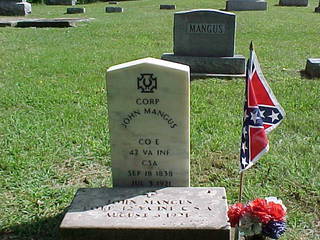
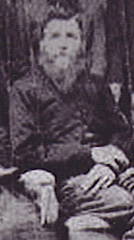


John Mangus moved to Indiana after the war, probably in 1881. He moved to Ladoga with his wife Sarah and 6 children. His Great-great-great grandfather was Andreas Mangus, who was a Hessian soldier who came to America to fight the British in the Revolutionary War and stayed after the fighting was over. John enlisted in the army in 1861 at the beginning of the Civil War and was assigned to Co. E of the 42nd Virginia Infantry. He served honorably until he was paroled after the surrender at the Appomattox Courthouse, being the only member of Company E to answer the roll call. The 42nd VA saw action in many battles during the war. Most notable of which were the 2nd Manassas, Harper's Ferry, Antietam, Fredericksburg, Chancellorsville, and finally Gettysburg. John Mangus was wounded at Antietam and Chancellorsville. John Chapla, in his history of the 42nd, observed that, "Clearly in the postwar era the surviving members of the Dixie Greys, Co. E of the 42nd Va. Inf., came to believe that he held a special status among the survivors." John Mangus died in 1921 and is buried at the Ladoga Cemetery.
NOAH MONROE BROCK
Noah Monroe Brock lived to the ripe old age of 105 and was the last surviving member of the Civil War in Montgomery County and probably in Indiana. He was born in North Carolina and enlisted in the army soon after the war began. According to his obituary, he rode with Lee's Cavalry. It further states, "Mr. Brock spent his boyhood on the farm near his birthplace and at the outbreak of the war joined 'Marse Robert's' Virginia cavalry serving with the unit for the duration of the conflict between the states. He had two brothers serving in the Confederate army and a third brother serving with the Union forces." Brock was very successful farmer in the Darlington area. He died in 1942 and is buried in the IOOF Cemetery in Darlington.
BRAXTON CASH 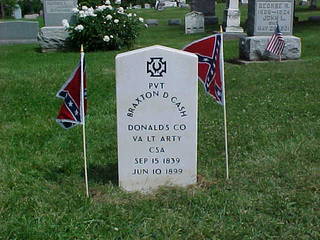

Braxton Cash was another prominent farmer who came to Montgomery County after the war and settled southwest of Crawfordsville. His obituary indicated that he was, "…a Confederate soldier who served in Stonewall Jackson's Black Horse Cavalry." He was buried with Masonic honors and was surrounded by fellow Masons who fought on the Union side. The speaker observed that, "The boys in blue filed around the grave of the boy in gray, depositing a sprig of evergreen upon his remains. Beneath these tributes of respect, the ex-confederate sweetly sleeps in peace. His last march is ended, his last battle fought and he silently bivouacs in the tentless field of the dead where he calmly awaits the bugle call when the blue and the gray will be marshaled under the one flag, the flag of peace." Braxton Cash died in 1899 and is buried in the Masonic Cemetery on Grant Street.
ANDY GAYHART 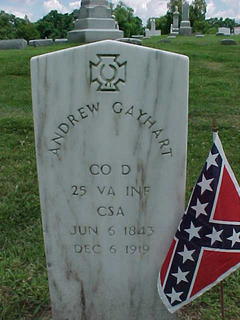

Andy Gayhart and his wife Catherine lived in Ladoga for almost 50 years after the war. Andy was a shoe-cobbler there for that time. He was born in Germany in 1843 and ran away from home to America settling in Virginia where he met his wife-to-be. When the Civil War started, Andy joined the Virginia cavalry and was assigned to Co. D of the 25th VA Cavalry. After the war, he and his wife came to Montgomery County and lived until their deaths. He was so beloved by the members of the Ladoga community that his friends offered to provide the necessities of life after he was unable to work. Andy and Catherine were too proud to accept that type of charity and chose to live out their years at the County Poor Farm outside of Crawfordsville. Catherine died in 1918 and Andy followed her a year later in 1919. Both are buried in the Ladoga Cemetery.
CLIFTON HILL
Clifton Hill was born in 1839 in Franklin County, VA. He was a member of the 42nd VA Inf. and fought in the Stonewall Brigade commanded by Stonewall Jackson. He was captured at the Second Battle of Bull Run at Manassas Junction. He was wounded several times, once finding sixteen holes in his uniform after the Battle of Cedar Mountain. He was wounded in the chest by a Minie ball at Cedar Mountain. He was also wounded at Sharpsburg or Antitetam where he was shot through the hip. He arrived in Indiana near Roachdale in Putnam County with only twenty-seven dollars and fifty cents in his pocket. He met his future wife, Hattie Hymer, in Putnam County and settled there and farmed. He later moved to Clark Twp., near Ladoga and became one of the most prosperous and respected farmers in the area, devoting himself to the breeding and raising of Shorthorn cattle. He died in 1922 and was buried in Roachdale Cemetery on the east side of town. His wife is also buried there.
MAURICE THOMPSON 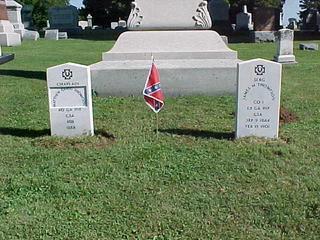
JAMES M. ANDERSON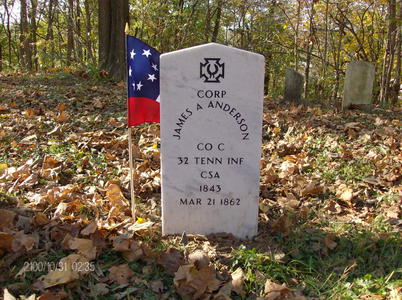
More information from Bill Boone -- thanks SO much for sharing all this Bill :)

One of the most famous of the Confederate soldiers who settled in Montgomery County was Maurice Thompson, the distinguished author, who along with Lew Wallace, the Union General who wrote the best seller Ben Hur, a Tale of the Christ, was thought to be one of the most gifted authors of his day. Maurice Thompson was actually born in Indiana, the son of a Baptist minister named Matthew Grigg Thompson. The pastor's callings led him to Missouri, where another son, Will H. Thompson was born and finally to Georgia about the time the Civil War started. All three Thompsons joined the Confederate Army in Georgia. Matthew became chaplain of the 46th Georgia Inf., Maurice was a scout for the 63rd GA Inf., and Will was a scout for the 4th Georgia Inf. The Thompson family holdings were devastated by the war and all three ended up in Crawfordsville, Indiana. Maurice and Will studied for the bar and had successful law practices in addition to their literary activities. Maurice wrote a best seller about the Revolutionary War entitled Alice of Old Vincennes and a book on archery which is still considered the definitive book on the subject. It was entitled, The Witchery of Archery. Will wrote two Civil War poems that were anthologized in many high school literature books. One was entitled "High Tide at Gettysburg," and the other "The Bonds of Blood." Maurice died at Crawfordsville in 1901 and is buried at Oak Hill Cemetery beneath a large memorial obelisk. Will moved to Seattle, Washington where he practiced law for the rest of his life. He is buried at Lakeview Cemetery in Seattle. Matthew Grigg Thompson returned to Missouri and settled at Ashland where he was killed in a fall from a horse. He is also buried at Oak Hill Cemetery at the Thompson Memorial. Below, thanks to Bill Boone are Maurice (James Maurice Thompson) & his father, Chaplain Matthew Grigg Thompson's graves
JAMES M. ANDERSON

The saddest of all stories of Confederates buried in Montgomery County is the story of James M. Anderson. Anderson was one of about 14,000 POWs from the surrender of Fort Donelson in Tennessee. These soldiers were shipped north, probably headed for Camp Douglas in Chicago. Keith Houk picked up the story in his article in The Montgomery County Family History book published in 1988. Houk writes, "He was taken north as a prisoner of war in early March of 1862. While being taken to the prison camp at Camp Tippecanoe in Lafayette, IN, he became sick and died on March 21, 1862. He died on the POW train near Crawfordsville. His body was left at Camp Lane in Crawfordsville and his remains were taken to Old Town Cemetery for burial. His gravesite is unmarked. James M. Anderson and John Bush, another Confederate POW who is buried in the Old Thorntown Cemetery in Thorntown, IN, were among many southern soldiers who died while prisoners of war on Hoosier soil."
More information from Bill Boone -- thanks SO much for sharing all this Bill :)
There were 38 Confederate POWs who died at Lafayette, IN, in February of 1862 and are buried at Greenbush Cemetery in Lafayette, but that story has already been written by Mary Immel in a book entitled, Beneath These Stones. Since I had Great-great grandfathers on each side of the conflict, I often wondered if they had ever been on the same battlefield. I ordered Thomas Peffley's military records and found out that he didn't see any action after becoming ill during his training camp experience. Then I wondered if my grandson, Dallas Grubbs' paternal Great-great-grandfather, Philip Grubbs, of the 7th Indiana Infantry had ever met his maternal Great-great-great-grandfather, John Mangus of the 42nd Virginia Infantry. One day while surfing the internet, I found a web-site that focused on the Battle of Gettysburg. I had just finished reading Killer Angels, a story of the three days at Gettysburg by Michael Sharra, so I was thinking about defining battle of the Civil War. I found a link that focused on Culp's Hill, a strategic site overlooking the main battlefield. Here is a quotation from that site, "As soon as the line was formed, Jones put pickets well toward the front. A patrol from the 42nd Virginia, sent out by General Johnson, reached nearly to the summit of Culp's Hill. But on the east slopes of that hill, in the dark the "unsuspecting squad of scouts" encountered a patrol from the 7th Indiana, and some of the 42nd men were captured." Dallas' grandfathers were on the same hill overlooking the main battlefield and could have met. If one had killed the other…
File Created: 1 Aug 2010

